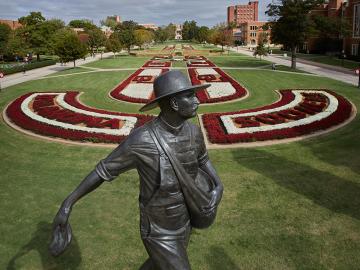
Filter News
Area of Research
- (-) Building Technologies (12)
- (-) Fusion Energy (17)
- (-) Materials for Computing (36)
- (-) National Security (79)
- Advanced Manufacturing (34)
- Biological Systems (18)
- Biology and Environment (177)
- Biology and Soft Matter (5)
- Chemical and Engineering Materials (4)
- Chemistry and Physics at Interfaces (11)
- Clean Energy (522)
- Climate and Environmental Systems (14)
- Computational Biology (6)
- Computational Chemistry (5)
- Computational Engineering (5)
- Computer Science (19)
- Data (1)
- Earth Sciences (1)
- Electricity and Smart Grid (3)
- Energy Frontier Research Centers (14)
- Energy Sciences (5)
- Fossil Energy (3)
- Fuel Cycle Science and Technology (3)
- Functional Materials for Energy (16)
- Fusion and Fission (54)
- Geographic Information Science and Technology (3)
- Isotope Development and Production (3)
- Isotopes (35)
- Materials (433)
- Materials Characterization (2)
- Materials Synthesis from Atoms to Systems (13)
- Materials Under Extremes (12)
- Mathematics (1)
- Neutron Data Analysis and Visualization (4)
- Neutron Science (190)
- Nuclear Science and Technology (74)
- Nuclear Systems Modeling, Simulation and Validation (3)
- Nuclear Systems Technology (1)
- Quantum Condensed Matter (4)
- Quantum information Science (9)
- Reactor Technology (1)
- Renewable Energy (4)
- Sensors and Controls (5)
- Supercomputing (311)
- Transportation Systems (11)
News Type
News Topics
- 3-D Printing/Advanced Manufacturing (8)
- Advanced Reactors (8)
- Artificial Intelligence (12)
- Big Data (6)
- Bioenergy (3)
- Biology (5)
- Biomedical (4)
- Biotechnology (1)
- Buildings (4)
- Chemical Sciences (6)
- Climate Change (5)
- Composites (1)
- Computer Science (28)
- Coronavirus (5)
- Cybersecurity (19)
- Decarbonization (2)
- Energy Storage (6)
- Environment (6)
- Exascale Computing (1)
- Frontier (2)
- Fusion (14)
- Grid (6)
- High-Performance Computing (4)
- Isotopes (1)
- Machine Learning (12)
- Materials (13)
- Materials Science (20)
- Microscopy (4)
- Nanotechnology (8)
- National Security (35)
- Neutron Science (9)
- Nuclear Energy (15)
- Partnerships (4)
- Physics (1)
- Polymers (6)
- Quantum Computing (1)
- Quantum Science (4)
- Security (12)
- Simulation (1)
- Space Exploration (1)
- Summit (4)
- Sustainable Energy (11)
- Transportation (7)
Media Contacts

A team led by the U.S. Department of Energy’s Oak Ridge National Laboratory demonstrated the viability of a “quantum entanglement witness” capable of proving the presence of entanglement between magnetic particles, or spins, in a quantum material.

ORNL and the University of Oklahoma, known as OU, recently executed a memorandum of understanding to officially recognize their partnership in pursuing shared research and development goals.

Analytical chemists at ORNL have developed a rapid way to measure isotopic ratios of uranium and plutonium collected on environmental swipes, which could help International Atomic Energy Agency analysts detect the presence of undeclared nuclear

Oak Ridge National Laboratory researchers have created a technology that more realistically emulates user activities to improve cyber testbeds and ultimately prevent cyberattacks.

Pengfei Cao, a polymer chemist at ORNL, has been chosen to receive a 2021 Young Investigator Award from the Polymeric Materials: Science and Engineering Division of the American Chemical Society, or ACS PMSE.

Oak Ridge National Laboratory researchers have developed a new catalyst for converting ethanol into C3+ olefins – the chemical

Researchers working with Oak Ridge National Laboratory developed a new method to observe how proteins, at the single-molecule level, bind with other molecules and more accurately pinpoint certain molecular behavior in complex

ASM International recently elected three researchers from ORNL as 2021 fellows. Selected were Beth Armstrong and Govindarajan Muralidharan, both from ORNL’s Material Sciences and Technology Division, and Andrew Payzant from the Neutron Scattering Division.

Oak Ridge National Laboratory researchers designed and field-tested an algorithm that could help homeowners maintain comfortable temperatures year-round while minimizing utility costs.

Deborah Frincke, one of the nation’s preeminent computer scientists and cybersecurity experts, serves as associate laboratory director of ORNL’s National Security Science Directorate. Credit: Carlos Jones/ORNL, U.S. Dept. of Energy


